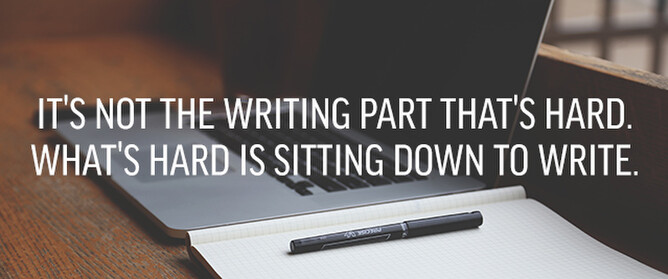It’s a funny thing, writing. Thanks to compulsory education and the invention of a movable-type printing press, most of us can do it. If you’re reading this, chances are you can string together enough words to form a semi-coherent email or scribble a few well wishes on a birthday card.
So why is writing website content so darn hard?
Prologue: Writing is daunting
It should be the easiest thing in the world. You learnt it as a kid. Just squiggles on a page. And yet, it’s tough. Our clients’ websites constantly get bogged down in the development stage because they can’t for the life of them write a few words about something in which they’re experts, namely their own business.
Bestselling author Steven Pressfield says there is a mysterious force, Resistance, that faces everyone undertaking a creative task—writing, painting, or origami-folding. However you explain Resistance, every writer and artist can vouch for its existence. Pressfield notes that the young Hitler dreamt of becoming a painter, pouring his inheritance into his arts education. “Ever see one of his paintings?,” Pressfield asks. “Neither have I. Resistance beat him. Call it overstatement but I'll say it anyway: it was easier for Hitler to start World War II than it was for him to face a blank square of canvas.”
The same goes for a blank page. That innocuous 13-inch screen becomes suddenly monolithic. You start to wonder if you’ll ever get this done. But I have good news: you can write your website copy (“copy” is just a hoity-toity way of saying “text”). This blog post will show you how to write good content for your website.
Two more things before we begin...Firstly, I’m focused here on writing for the web in general. A lot of this advice will apply to blogging too, but read here for specific guidance about writing for your blog. Secondly, writing for the web is unique, because it requires that you not only (1) communicate clearly, but also (2) write in a way that will bump your website as high up the Google search rankings as possible. Here, I cover only the first sense, BUT we’ve blogged extensively about the second sense, called search engine optimisation (SEO). Read more about SEO here.
Chapter 1: Structure
It’s important to organise and structure your content. Remember: this isn’t Joycean, stream-of-consciousness prose, so don’t spew whatever comes to mind out onto the page in random order. Instead:
- Make it easy to scan
For almost twenty years, web usability experts NNG have been preaching the importance of making your writing scannable. Readers should be able to get the gist from a quick glance rather than having to read closely and carefully. Specifically, use lots of headings, sub-headings, numbered and bulletpoint lists, emphasised text (don’t go overboard!) and “chunking” (breaking content into small, manageable bits). If reading a novel is like getting lost in the woods, reading web content should be like having an over-eager tour guide who’s constantly pointing out things and just won’t shut up.
- Be concise
The best scribes can write with economy. Being succinct is another of NNG’s cornerstone principles of web writing. But that’s easier said than done, so how? (1) Be clear on the point of this particular webpage, paragraph and sentence (keep in mind what you’re ultimately trying to say), and; (2) edit your work repeatedly, mercilessly cutting away any fat.
- Let the topic determine the length
Despite the importance of brevity, long-form copy often works better than skimpy content. I realise this is counterintuitive, but it’s a fact borne out by plenty of research. Webpages with upwards of 1,500 words often rank highest in Google. Which presents the web writer with a conundrum: short (yay, concise!) or long (yay, higher ranking!)? The answer is simple: if the topic deserves detailed, in-depth treatment, go long. If not, keep it brief.
- Put your most important ideas first
The more important it is, the earlier it should appear. This is a good rule of thumb for web content in general (e.g., research shows that users pay 84% more attention to information “above the fold”) but also applies specifically to how you structure your copy. NNG recommends using an “inverted pyramid” structure, where you give your conclusion in the introduction. That makes sense...to a point. Don’t let your zeal for giving pole position to the key idea(s) trump the logic—or drama!—of your writing.
Chapter 2: Style
Nailing your structure is important, but it’s not everything. The best web writing isn’t only functional; it’s beautiful as well. Indeed, one of the joys of reading—and, yes, even writing—is appreciating the beauty and plain ol’ fun of language. With that in mind:
- Charm your audience
Business website copy isn’t meant to be neutral and objective; it should be persuasive. But since “persuasion” sounds a little too much like “coercion”, I prefer to think of it as charming your audience: less gun-to-the-head, more chocolate-coated-and-covered-in-sprinkles. How? Your writing should be trying to motivate the audience (e.g., to buy your product, sign up for your emails, contact you for a quote, or even just keep reading), but shouldn’t be a hard-sell. Back your product but don’t overhype it.
- Use objective language...sometimes
Real estate researchers have made an interesting discovery: in house listings, emotive language like “fantastic” and “spacious” correlates with lower sale prices, while neutral language like “granite” and “maple”correlates with higher prices. Why? Subjective words are unconvincing. “Fantastic” is an opinion; “granite” is a fact (and suggests quality). This is (partly) why NNG recommends using objective language. But tread carefully: facts-only writing can turn dull very fast, so my advice is to blend objective and subjective language so that it’s equal parts credible and compelling.
- Find your voice
“Voice” is your copy’s tone, how it sounds or feels. Since it’s essentially your writing’s “personality”, it should match the personality of your business. NNG helpfully demystifies tone by breaking it down into four metrics: (1) funny vs. serious, (2) casual vs. formal, (3) irreverent vs. respectful, (4) enthusiastic vs. matter-of-fact. What tone works best? That’ll vary from one business to another, but NNG’s testing revealed that, on the whole, “casual, conversational, and moderately enthusiastic tones performed best”. Better to err on the side of friendly and human than cold and corporate. So don’t just copy-and-paste the corporatese from your mission statement!
- Bookend paragraphs with snappy sentences
Good writers have Sprachgefühl, an intuitive sense of how good writing sounds. Problem is, a feel for language is difficult to teach. So here’s a quick-and-dirty tip for constructing little paragraphs that snap, crackle and pop: start and finish your paragraphs with a sentence or phrase that has a lil’ sizzle (i.e., is funny, clever, ironic, colloquial, or punchy). Even dull, utilitarian lines will sound right—or at least better—when sandwiched between a couple of sexy sentences.
- Read, re-read and edit
Nothing says “amateur” like spelling and grammar errors. In their rush to churn out content, even major newspapers—traditionally bastions of proper literary style—are regular offenders (NZ Herald, I’m looking at you...). Fortunately, it’s an easy fix: read and re-read your work. Pore over it with a fine-tooth comb (reading it aloud can also help you identify problems with tone and style). And, if possible, put your writing aside for a day or two and come back to it. With a little distance, problems—orthographic or stylistic—will jump out at you.
Chapter 3: Process
“There's a secret,” says Pressfield, “that real writers know that wannabe writers don't, and the secret is this: It's not the writing part that's hard. What's hard is sitting down to write.” Even seasoned writers—who know the above principles inside-out—have trouble actually doing it. So:
- Set small targets
In her celebrated book about writing, Bird By Bird, Anne Lamott, suggests “short assignments” as one way of fighting through Resistance. Don’t sit down to write your whole website (or even whole webpage), in one go. Just try to write one paragraph. Heck, even one sentence is an accomplishment. And once you get the ball rolling, you might find you can write a lot more.
- First write for sense, then write for style
Sometimes what paralyses us before the blank page is the pressure, usually self-inflicted, to be brilliant. Rather than trying to write crackling prose from the get-go, dedicate your first draft to the more modest goal of simply making sense. Freed from the need to be Keats, you can focus instead on constructing a clear, logical and comprehensive piece. Then, on your second go-through, focus on style: choose better words, vary sentence lengths, and work in a few jokes.
- Let “what’s my point?” be your guide
Sometimes you get lost. You come to the end of a thought or get mired in a complex explanation or find yourself on some unexpected excursus—and you’ve got no idea what to write next. How do you find your way again? By asking yourself: What’s my point? Maybe even write that point in BIG FAT LETTERS at the top of your page. Knowing your overarching point is like marking an “X” on your map (or, to be a lil’ more 21st century, dropping a pin on your Google map). It keeps you on track and, when you come off, helps you get back on.
Conclusion: Not easy, but doable
Writing well is never easy. It’s just one of those things, like exercising or ironing button-up shirts, that always demands a lot of you. But don’t be overwhelmed. You got this. Just think in terms of structure, style, and process:
- Structure
- Make it easy to scan
- Be concise
- Let the topic determine the length
- Put your most important ideas first
- Style
- Charm your audience
- Use objective language...sometimes
- Find your voice
- Bookend paragraphs with snappy sentences
- Read, re-read and edit
- Process
- Set small targets
- First write for sense, then write for style
- Let “what’s my point?” be your guide
Take these principles on board and you’ll find you have many of the tools you need to write solid web copy.
So, what are you waiting for? That website ain’t gonna write itself.
By Richard Goodwin
Richard Goodwin has been writing for Rocketspark and our clients since 2013. When he’s not penning articles for us, you’ll find him working on his PhD or building forts with his young son.






